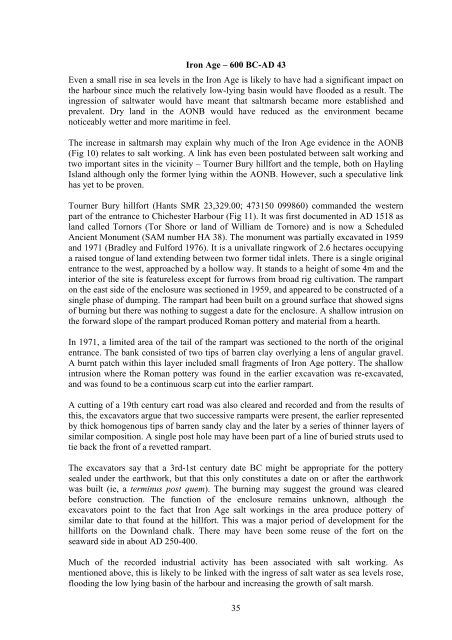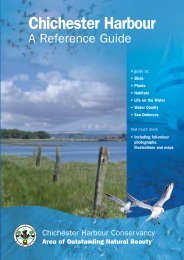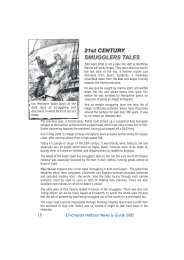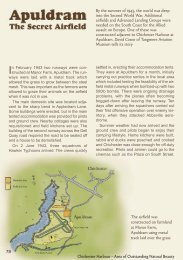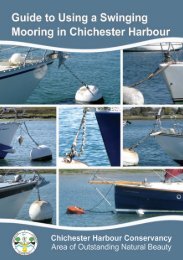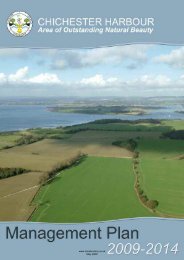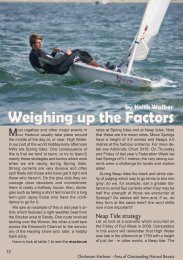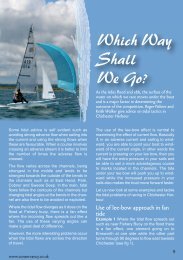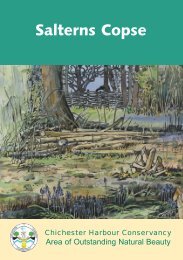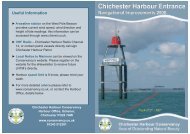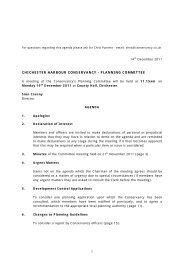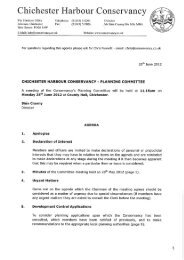Iron Age â 600 BC-AD 43 - Chichester Harbour Conservancy
Iron Age â 600 BC-AD 43 - Chichester Harbour Conservancy
Iron Age â 600 BC-AD 43 - Chichester Harbour Conservancy
Create successful ePaper yourself
Turn your PDF publications into a flip-book with our unique Google optimized e-Paper software.
<strong>Iron</strong> <strong>Age</strong> – <strong>600</strong> <strong>BC</strong>-<strong>AD</strong> <strong>43</strong><br />
Even a small rise in sea levels in the <strong>Iron</strong> <strong>Age</strong> is likely to have had a significant impact on<br />
the harbour since much the relatively low-lying basin would have flooded as a result. The<br />
ingression of saltwater would have meant that saltmarsh became more established and<br />
prevalent. Dry land in the AONB would have reduced as the environment became<br />
noticeably wetter and more maritime in feel.<br />
The increase in saltmarsh may explain why much of the <strong>Iron</strong> <strong>Age</strong> evidence in the AONB<br />
(Fig 10) relates to salt working. A link has even been postulated between salt working and<br />
two important sites in the vicinity – Tourner Bury hillfort and the temple, both on Hayling<br />
Island although only the former lying within the AONB. However, such a speculative link<br />
has yet to be proven.<br />
Tourner Bury hillfort (Hants SMR 23,329.00; 473150 099860) commanded the western<br />
part of the entrance to <strong>Chichester</strong> <strong>Harbour</strong> (Fig 11). It was first documented in <strong>AD</strong> 1518 as<br />
land called Tornors (Tor Shore or land of William de Tornore) and is now a Scheduled<br />
Ancient Monument (SAM number HA 38). The monument was partially excavated in 1959<br />
and 1971 (Bradley and Fulford 1976). It is a univallate ringwork of 2.6 hectares occupying<br />
a raised tongue of land extending between two former tidal inlets. There is a single original<br />
entrance to the west, approached by a hollow way. It stands to a height of some 4m and the<br />
interior of the site is featureless except for furrows from broad rig cultivation. The rampart<br />
on the east side of the enclosure was sectioned in 1959, and appeared to be constructed of a<br />
single phase of dumping. The rampart had been built on a ground surface that showed signs<br />
of burning but there was nothing to suggest a date for the enclosure. A shallow intrusion on<br />
the forward slope of the rampart produced Roman pottery and material from a hearth.<br />
In 1971, a limited area of the tail of the rampart was sectioned to the north of the original<br />
entrance. The bank consisted of two tips of barren clay overlying a lens of angular gravel.<br />
A burnt patch within this layer included small fragments of <strong>Iron</strong> <strong>Age</strong> pottery. The shallow<br />
intrusion where the Roman pottery was found in the earlier excavation was re-excavated,<br />
and was found to be a continuous scarp cut into the earlier rampart.<br />
A cutting of a 19th century cart road was also cleared and recorded and from the results of<br />
this, the excavators argue that two successive ramparts were present, the earlier represented<br />
by thick homogenous tips of barren sandy clay and the later by a series of thinner layers of<br />
similar composition. A single post hole may have been part of a line of buried struts used to<br />
tie back the front of a revetted rampart.<br />
The excavators say that a 3rd-1st century date <strong>BC</strong> might be appropriate for the pottery<br />
sealed under the earthwork, but that this only constitutes a date on or after the earthwork<br />
was built (ie, a terminus post quem). The burning may suggest the ground was cleared<br />
before construction. The function of the enclosure remains unknown, although the<br />
excavators point to the fact that <strong>Iron</strong> <strong>Age</strong> salt workings in the area produce pottery of<br />
similar date to that found at the hillfort. This was a major period of development for the<br />
hillforts on the Downland chalk. There may have been some reuse of the fort on the<br />
seaward side in about <strong>AD</strong> 250-400.<br />
Much of the recorded industrial activity has been associated with salt working. As<br />
mentioned above, this is likely to be linked with the ingress of salt water as sea levels rose,<br />
flooding the low lying basin of the harbour and increasing the growth of salt marsh.<br />
35
In addition to this, the channels of the harbour offered good transport. Many of the known<br />
salt workings in the AONB are concentrated on Chidham’s west coast and at the head of<br />
Thorney Channel. <strong>Iron</strong> <strong>Age</strong> salt works were surveyed by Bradley and some are known<br />
from excavations at Chidham (Bedwin 1980) (Chi SMR 205, 251; 477930 103830, 477900<br />
103780). At Bradley’s salt working site 18, the latter of these two sites, a small Early <strong>Iron</strong><br />
<strong>Age</strong> pit may have been an evaporation pan for salt production. Both sites were also yielded<br />
Neolithic pottery. Another salt working site at Chidham (Chi SMR 248; 478200 103930),<br />
Bradley’s site 19, the finds of calcinated flint, a few <strong>Iron</strong> <strong>Age</strong> and Roman sherds and a few<br />
fragments of burnt clay, may have been instead associated with ploughing in the area<br />
(Bedwin 1980). Slightly further north up the coast at Nutbourne Creek, a Middle to Late<br />
<strong>Iron</strong> <strong>Age</strong> salt working site (Chi SMR 240; 477980 103480) was also found (Bradley’s Site<br />
B) in addition to a Roman inhumation.<br />
Salt workings are also to be found at the north end of Thorney Channel. Bradley’s site 18<br />
(Chi SMR 250; 477570 104810) is located below the high water mark and the dating is<br />
imprecise (Bedwin 1980). Bradley’s site 16 (Chi SMR 253; 476990 104730) yielded a<br />
large feature with sherds of pottery and calcinated flint. Cartwright’s site CH-52 (Chi SMR<br />
220; 478000 103<strong>43</strong>0) yielded a number of Early <strong>Iron</strong> <strong>Age</strong> and Late <strong>Iron</strong> <strong>Age</strong>/Romano-<br />
British sherds (Cartwright 1984). At Thornham Boat Yard, <strong>Iron</strong> <strong>Age</strong> occupation debris of<br />
‘uncertain nature’ (Chi SMR 244; 476350 104710) was overlain by a large 1st century<br />
Roman saltern.<br />
Two <strong>Iron</strong> <strong>Age</strong> salt workings were located on the headland between Bosham and Bosham<br />
Hoe. Bradley’s Site 20 (Chi SMR 254; 479770 102780) consisted of five badly struck cores<br />
and flakes and a scatter of calcinated flint on the shore. Bradley’s site 21 (Chi SMR 255;<br />
479800 102490) included fired clay fragments, but these were probably not briquetage<br />
(Bedwin 1980).<br />
The <strong>Iron</strong> <strong>Age</strong> has other evidence for industrial activity where it is less clear what processes<br />
were taking place. Four hearths were visible in 1969 in a section of low sea cliff opposite<br />
Verner Common (Hants SMR 23,519.00, 23,520.00, 23,521.00, 23,522.00; 473400<br />
101670, 473420 101640, 473450 101510, 473450 101460 respectively). These hearths<br />
were thought to be <strong>Iron</strong> <strong>Age</strong>, although no finds were retrieved. It is plausible that they were<br />
associated with salt working, but this is speculation.<br />
<strong>Iron</strong> <strong>Age</strong> settlements, major hillforts, and cemeteries are all known from the wider area<br />
outside the AONB, for example at <strong>Chichester</strong>, the Trundle and Westhampnett. However,<br />
no evidence for <strong>Iron</strong> <strong>Age</strong> settlement has been found within the AONB itself, or indeed in<br />
the adjacent Langstone harbour (Allen and Gardiner 2000). Even short-term and temporary<br />
timber structures, like that identified in other areas of <strong>Iron</strong> <strong>Age</strong> wetlands with salt marsh<br />
(Bell et al 2000), have not been identified, although that is not to say that they will not be<br />
found in the future.<br />
However, although evidence is lacking, an obvious candidate for at least Late <strong>Iron</strong> <strong>Age</strong><br />
settlement is Fishbourne. It was a pivotal early Roman site. In fact, Fishbourne may have<br />
started life as a placed trading post. Similarly, the fact that <strong>Iron</strong> <strong>Age</strong> pottery is scattered<br />
across the AONB suggests that there may at least have been temporary or seasonal<br />
occupation. Often the pottery has been found in association with pot boilers (large firecracked<br />
pebbles heated in a fire and placed in a liquid to boil it), for example at Thorham<br />
Point (Chi SMR 177, 178; 476550 104400, 476580 10<strong>43</strong>70), on Hayling Island (Hants<br />
SMR 23,569.00; 473670 102510) and at Cartwright’s site CH-61 (Chi SMR 231; 476930<br />
104880). This last find is interesting, since <strong>Iron</strong> <strong>Age</strong> pottery has been found on other<br />
36
Neolithic sites, too, for example an Early <strong>Iron</strong> <strong>Age</strong> potsherd found on a flint working site<br />
(Chi SMR 117; 476760 105100), Early <strong>Iron</strong> <strong>Age</strong> pottery (Chi SMR 120; 476630 105000)<br />
found on Cartwright site CH-63 (Cartwright 1984), at Cartwright’s site CH-67 (Chi SMR<br />
233; 476400 104560), and over 250 sherds of Late <strong>Iron</strong> <strong>Age</strong> pottery found at Cartwright’s<br />
site CH-65 (Chi SMR 186; 476380 104700). This is perhaps not enough evidence to<br />
demonstrate continuity between these two periods on these sites, but future research may<br />
provide the opportunity to investigate the links between these two periods. Early <strong>Iron</strong> <strong>Age</strong><br />
pottery has also been found on Thorney (Chi SMR 190; 476580 102<strong>43</strong>0) and in the<br />
northeast part of the AONB (Chi SMR 2331; 484000 104000).<br />
A number of stray finds are also known for this period. These include coins, statuary and<br />
other items. It would be tempting to see these as evidence to support the theory that the<br />
area was becoming increasingly Romanised, a process accelerated by trade with the<br />
Continent (a Greek and a Gallo Belgic coin have both been found in the AONB – see<br />
below). However, there must be a note of caution about these items that lack a well-dated<br />
archaeological context. <strong>Chichester</strong> was a port, and some of the stray finds may have been<br />
imported at a much later date, for example during the 19th century when the concept of the<br />
‘Grand Tour’ around Europe was popular and items of historical interest were brought back<br />
to England (James Kenny pers comm.).<br />
That said, the representation of a Celtic Mother Goddess (Chi SMR 2498; 484000 104000),<br />
found near Fishbourne may be pre-Conquest, although the cult was revived and popular<br />
among Gaulish troops in Imperial Army especially in the 2nd and 3rd centuries. A ‘Celtic<br />
head made of Bath stone’ (Chi SMR 2440; 481<strong>600</strong> 104700) was found north-east of<br />
Bosham. The Greek coin is of Hieron II (275-216 <strong>BC</strong>) found in the mud at Hermitage (Chi<br />
SMR 96; 475000 105000). The Gallo Belgic coin and a Langton Down type brooch (Hattat<br />
type 39) were recovered at Broadbridge (Chi SMR 1254 and 1255 respectively; both<br />
481000 105000), with a further coin was found at Apuldram Farm (Chi SMR 2390; 484200<br />
103500). A quarter stater coin attributed to Atrebates (Chi SMR 2489; 484000 104000) is<br />
likely to be bona fide, since the AONB was firmly within the tribal territory of the<br />
Atrebates during the later <strong>Iron</strong> <strong>Age</strong> (Cunliffe 1991).<br />
Research questions<br />
Future research should address how the landscape was used in the <strong>Iron</strong> <strong>Age</strong>, and whether<br />
any evidence of settlement can be identified. Most of the evidence points to the AONB<br />
being used for salt making in this period, although there are hints that the true picture may<br />
have been more complex – for example the function of Tourner Bury hillfort is not fully<br />
understood, or whether the roots of the Fishbourne site extend into the <strong>Iron</strong> <strong>Age</strong>, perhaps as<br />
a trading post.<br />
There are also unresolved questions about trade and supply in the <strong>Iron</strong> <strong>Age</strong>. Was the<br />
<strong>Harbour</strong> a major trading route, and was water transport more important than transport on<br />
land<br />
37


